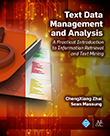Text Data Management and Analysis A Practical Introduction to Information Retrieval and Text Mining
 ChengXiang Zhai, Sean Massung ChengXiang Zhai, Sean MassungISBN: 9781970001167 | PDF ISBN: 9781970001174 Hardcover ISBN: 9781970001198 Copyright © 2016 | 471 Pages | Publication Date: July, 2016 |
This book provides a systematic introduction to a wide range of statistical and heuristical approaches to the management and analysis of text data. It emphasizes the most useful knowledge and skills required to build a variety of practically useful text information systems. Because humans can understand natural languages far better than computers can, effective involvement of humans in a text information system is generally needed and text information systems often serve as intelligent assistants for humans.
Depending on how a text information system collaborates with humans, we distinguish two kinds of text information systems. The first is information retrieval systems which include search engines and recommender systems; they assist users in finding from a large collection of text data the most relevant text data that are actually needed for solving a specific application problem, thus effectively turning big raw text data into much smaller relevant text data that can be more easily processed by humans. The second is text mining application systems; they can assist users in analyzing patterns in text data to extract and discover useful actionable knowledge directly useful for task completion or decision making, thus providing more direct task support for users.
The book covers the major concepts, techniques, and ideas in information retrieval and text data mining from a practical viewpoint, and includes many hands-on exercises designed with a companion software toolkit (i.e., META) to help readers learn how to apply techniques of information retrieval and text mining to real-world text data and how to experiment with and improve some of the algorithms for interesting application tasks. The book can be used as a textbook for computer science undergraduates and graduates, library and information scientists, or as a reference book for practitioners working on relevant problems in managing and analyzing text data.
Table of Contents
Part I: Overview and Background
1. Introduction
2. Background
3. Text Data Understanding
4. MeTA: A Unified Toolkit for Text Data Management and Analysis
Part II: Text Data Access
5. Overview of Text Data Access
6. Retrieval Models
7. Feedback
8. Search Engine Implementation
9. Search Engine Evaluation
10. Web Search
11. Recommender Systems
Part III: Text Data Analysis
12. Overview of Text Data Analysis
13. Word Association Mining
14. Text Clustering
15. Text Categorization
16. Text Summarization
17. Topic Analysis
18. Opinion Mining and Sentiment Analysis
19. Joint Analysis of Text and Structured Data
Part IV: Unified Text Data Management Analysis System
20. Toward a Unified System for Text Management and Analysis
About the Author(s)
ChengXiang Zhai, University of Illinois at Urbana-Champaign
ChengXiang Zhai is a Professor of Computer Science and Willett Faculty Scholar at the University of Illinois at Urbana-Champaign, where he is also affiliated with the Graduate School of Library and Information Science, Institute for Genomic Biology, and Department of Statistics. He received a Ph.D. in Computer Science from Nanjing University in 1990, and a Ph.D. in Language and Information Technologies from Carnegie Mellon University in 2002. He worked at Clairvoyance Corp. as a Research Scientist and then Senior Research Scientist from 1997 to 2000.
Sean Massung, University of Illinois at Urbana-Champaign
Sean Massung is a Ph.D. candidate in computer science at the University of Illinois at Urbana-
Champaign, where he also received both his B.S. and M.S. degrees. He is a co-founder of
META and uses it in all of his research. He has been instructor for CS 225: Data Structures and Programming Principles, CS 410: Text Information Systems, and CS 591txt: Text Mining Seminar. He is included in the 2014 List of Teachers Ranked as Excellent at the University of Illinois and has received an Outstanding Teaching Assistant Award and CS@Illinois Outstanding Research Project Award. He has given talks at Jump Labs Champaign and at UIUC for Data and Information Systems Seminar, Intro to Big Data, and Teaching Assistant Seminar. His research interests include text mining applications in information retrieval, natural language processing, and education.
Reviews
In general terms, the authors typically provide verbose descriptions of the reasons behind the design of specific techniques, with numerical examples and illustrative figures from the slides of two massive open online courses (MOOCs) offered by the first author on Coursera. They also provide specific sections that describe in detail the proper way to evaluate every different kind of technique, a key factor to be taken into account when applying the discussed techniques in practice.
Fernando Berzal – In “Computing Reviews”